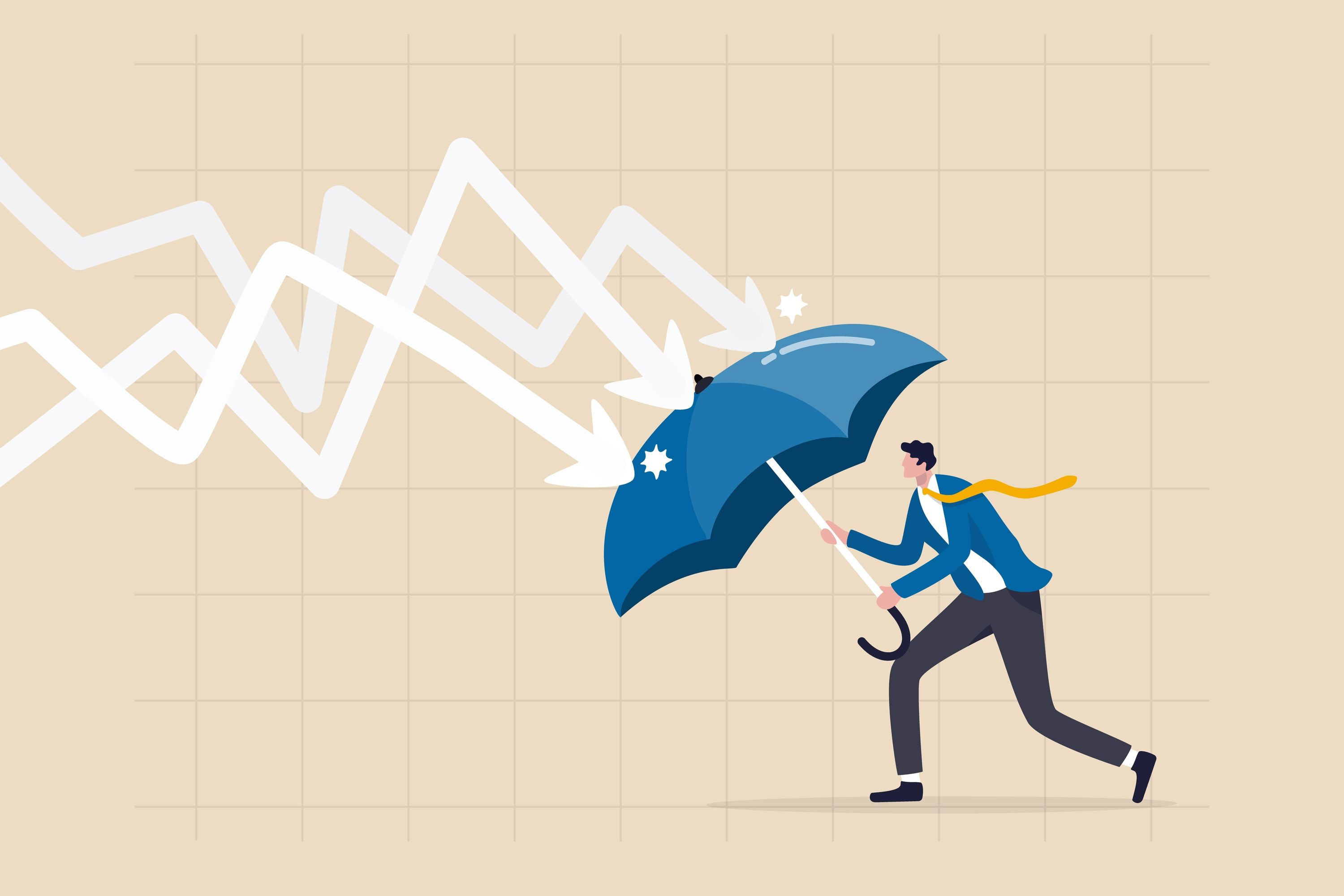Inflation, roller-coaster markets, global events, and life circumstances can test anyone's fortitude...
Oct 24, 2022
How to Adjust Your Budget for Inflation
If it seems like inflation is on everyone’s mind lately, there's a good reason for that: inflation has gone up by more than 8% over the past year1. Inflation has risen because of ongoing supply chain problems, government spending, rebound consumer spending following COVID-19 lockdowns, the war in Ukraine, and more. As a result, we’re seeing higher prices and worries about a recession.
That’s where the Federal Reserve System, also known as the Fed, comes in. The Fed is the central banking system in the U.S.—one of their tasks is to regulate inflation by adjusting the Federal Funds Rate. Most recently, the Fed raised the Federal Funds Rate by 0.75 percentage points, marking the third time the rate has been hiked by that amount in recent months, in an attempt to get inflation under control.
It’s good to know that the Fed is supposed to address inflation at the national level, but what about you, as an individual? What can you do to tackle the day-to-day experience of inflation and its impact on your budget? We’re so glad you asked.
How Does Inflation Affect Your Budget?
First, it’s important to understand that while overall inflation has risen over the past year, that doesn’t mean costs have risen the same amount across the board. Your personal budget might experience greater or lesser impacts as a result of inflation depending on things like your spending habits and even where you live.
For example, inflation affects consumer goods in different ways. Food prices have gone up dramatically—but in different ways. The cost of eggs has gone up nearly 40%, while the price for fruits and vegetables only went up by about 9%2. Inflation, the drought in Brazil, and the war in Ukraine all play a role in the changing price of food.
Prices for home goods like furniture and bedding have gone up by more than 10%3. If you’ve traveled recently, you probably also noticed that the cost of a home away from home has gone up, too: prices for hotels and other lodging have risen by 17.5%.
Energy is another area where inflation has an impact. Gas prices are still significantly higher than they were a year ago: while it’s down from the summer peak, the price of gasoline is up 44.6%—and the price of residential electricity has risen by nearly 16%4,5.
Where you live also plays a role in how inflation will affect your daily life and budget. Average inflation in New York was 6.7% over the previous year—while inflation in Phoenix had risen 12.3%6. The Joint Economic Committee reported that the Mountain West states have the highest rate of inflation7. In fact, regional differences are the greatest they’ve been in the past four decades. Where you live plays a surprisingly large role in how much of an impact inflation can have.
Making Inflation Adjustments
So what can you actually do to address inflation and keep it from totally disrupting your life? We’ve got a checklist that just might help.
Step 1: Track your spending
The first thing to do is to track your spending—consider creating a spreadsheet, filling out a budget tracker worksheet or journal, or using an app or online platform. It’s easier to make changes if you can see all your spending in one place! Once you begin tracking your expenses, then you can:
- Categorize your expenses and watch for any changes over time
- Identify purchases that are getting more expensive
Once you’ve noticed areas where your spending is going up, figure out whether those areas are affected by inflation. There are a few ways you can bring some of those costs down:
- Reduce the amount that you purchase (whether in terms of quantity or frequency)
- Look for substitutes—even temporary ones—to provide you with a cheaper alternative
Step 2: Reduce your expenses
Then, you can start looking for opportunities to reduce spending in other areas. Some spending is fixed, but even costs that seem set in stone can be flexible!
- Call your credit card provider to see if you qualify for a reduced interest rate
- Call your cell phone, cable, and internet providers to see if you qualify for a reduced rate
- Check your spending to see if you can cut out unused subscriptions. You can also look for bundled options to reduce costs, and set up shared accounts with your family and friends
- Watch your spending for other discretionary costs that you can cut, reduce, or substitute with less expensive options
Step 3: Use interest to your advantage
Now is a great time to take advantage of the rising interest rate environment! As the Fed raises its key interest rates, banks are able to offer more incentives to consumers who have traditional and high-yield savings accounts. Currently, interest rates on savings accounts are the highest they’ve been since 20098.
This means that the more money you save, the more money you can earn. Once you’ve tracked and reduced your spending, then you can:
- Check with your bank to see if you have a competitive rate in your traditional savings account or open a high-yield savings account
- Set up a small recurring deposit to build your savings even more each month
Bringing It All Together
Inflation means daily life feels a lot more expensive, and it can seem as if there’s not much you can do to avoid its impact on your budget. However, with just a few tweaks, you can keep more money in your pocket (or in your savings account!).
If you feel like you need more guidance, reach out to a trusted financial professional—our team is here to help!
Prepared by a third-party.
1. Coinnews Media Group LLC . (2022, October). “Current US Inflation Rates: 2000-2022: US Inflation Calculator.” https://www.usinflationcalculator.com/inflation/current-inflation-rates/
2. Wiener-Bronner, D. (2022, August 10). “Food Prices Are Skyrocketing, and It's Not Just Because of Inflation | CNN Business.” https://www.cnn.com/2022/08/10/business/grocery-prices#:~:text=The%20prices%20of%20nearly%20every,vegetables%20got%209.3%25%20more%20expensive
3. Buchholz, K. (2021, October 25). “Apples, Beef and Cars: This Is How Inflation Is Impacting Prices in the U.S.” https://www.weforum.org/agenda/2021/10/us-inflation-hits-cars-meats-lodging
4. Karydes, M. (2022, September 1). “Countries with the Highest Inflation: How U.S. Prices Compare Globally.” https://www.forbes.com/advisor/personal-finance/inflation-by-country/
5. Horsley, S. (2022, September 13) “Soaring Electricity Bills Are the Latest Inflation Flashpoint.” https://www.npr.org/2022/09/13/1122371879/electricity-utilities-gasoline-gas-prices-inflation-august-cpi-consumer-prices
6. The Economist Newspaper. (2022, October 13) “Regional Differences in American Inflation Hit a 40-Year High.” https://www.economist.com/graphic-detail/2022/08/02/regional-differences-in-american-inflation-hit-a-40-year-high
7. United States Joint Economic Committee. (2022, August 10) “State Inflation Tracker: July 2022.” https://www.jec.senate.gov/public/index.cfm/republicans/2022/8/state-inflation-tracker-july-2022
8. Konish, L. (2022, September 26) “Savings Rates Climb to Levels Not Seen since 2009. Here's How to Get the Best Return on Your Money.” https://www.cnbc.com/2022/09/26/where-to-get-the-best-return-on-your-cash-amid-rising-interest-rates.html[
You may also like
May 16, 2023
Key Takeaways Employ simple strategies to enhance your financial wellness: focus on what you can con...
Jun 27, 2019
Inflation averaged 2.5% for the 30-year period from 1989 to 2018. Although the recent trend is below...









